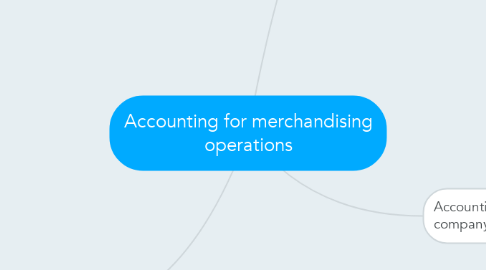
1. Accounting in merchandising company - periodic inventory system
1.1. Incom statement
1.2. Accounting for revenue from sales
1.2.1. Accounting for revenue from sales in merchnadising company which used the periodic inventory system is basically the same as that of a merchandising company which used the perpetual inventory system
1.3. Accounting for cost of goods sold
1.3.1. Accounting for perchases of merchandise
1.3.1.1. Accounting for purchases at the gross method
1.3.1.2. Accounting for purchases with purchases discounts
1.3.1.3. Accounting for purchases at the net method and control of purchases discounts
1.3.2. Accounting for purchases returns and allowances
1.3.2.1. In periodic inventory system, it is credited purchases returns and allowances account: this account is a contra account and is accordingly đeucted from purchases in the income statement
1.3.3. Freight in
1.3.3.1. Accounting for freight in in merchnadising company which used the periodic inventory system is basically the same as that of a merchandising company which used the perpetual inventory syste
1.3.4. Accounting for merchandise inventory - cost of goods sold
1.4. Accounting for operating expenses
1.4.1. Accounting for operating expenses in merchnadising company which used the periodic inventory system is basically the same as that of a merchandising company which used the perpetual inventory system
1.5. Income summary
1.5.1. End of the accounting period, income or loss is counted by preparing the closing entries depend on whether using income summary account
1.6. Prepare the work sheet under periodic inventory system
1.6.1. The adjusting entry method
1.6.2. The closing entry method
2. Overview
2.1. Income statement for a merchandising concern. It has three major parts
2.1.1. Revenue from sales
2.1.2. Cost of goods sold
2.1.3. Operating expenses
2.2. Operating cycle in merchandising company begins with the purchase and to end with sales on credit or sales for cash
2.2.1. Trade discounts
2.2.2. Sales discounts
2.2.3. Shipping terms
3. Accounting in merchandising company - perpetual inventory system
3.1. Income statement
3.2. Accounting for revenues from sales
3.2.1. Gross sales
3.2.2. Sales returns and allowances
3.2.3. Sales discounts
3.3. Accounting for cost of goods sold
3.3.1. Net purchases and net cost of purchases
3.3.1.1. Accounting for purchases at the gross method
3.3.1.2. Accounting for purchases with purchases discounts
3.3.1.3. Accounting for purchases at the net method and control of purchases discounts
3.3.2. Accounting for purchases returns and allowances
3.3.2.1. In perpetual inventory system: purchases returns and allowances is decreased merchadise inventory and is decreased account payable
3.3.3. Freight in
3.3.3.1. Freight in (transportation in) is customany forr the supplier (seller) pay transportation costs or it is customany for the purchases to pay transportation charges on merchandise
3.3.3.2. The supplier pays the freight charges but bills the buyer by including them as a separate accounts item on the sales invoice
3.3.4. Accounting for merchandise inventory - cost of goods sold
3.4. Accounting for operating expenses
3.4.1. Operating expenses is the third major of the income statement for a merchandising concern
3.4.2. include
3.4.2.1. selling expenses
3.4.2.2. general and administrative expenses
3.5. Income summary
3.5.1. End of the accounting period, income or loss is counted by preparing the closing entries depend on whether using income summary account
3.6. The work sheet for a merchandising concern
3.6.1. The work sheet of a merchandising business - perpetual inventory system is basically the same as that of a service business
3.6.2. Except that it has to deal with the new accounts
